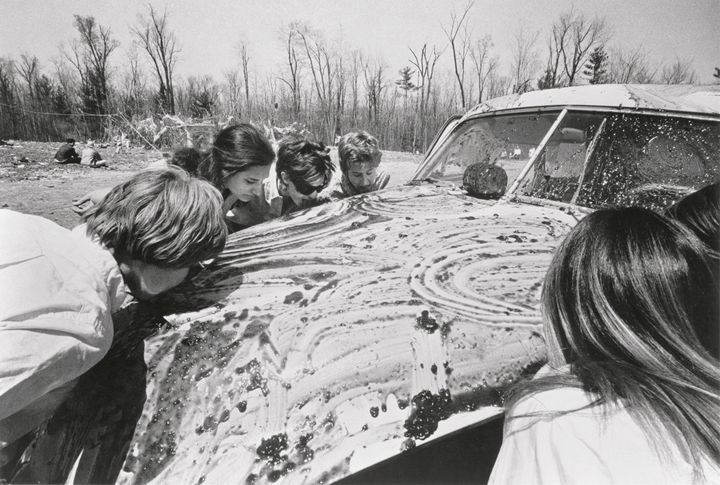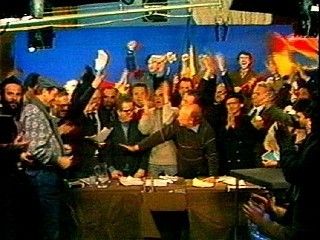It has been over 50 years since Allan Kaprow’s Assemblages, Environments and Happenings was published, and from the distance of history we can begin to compare today’s art with his prescriptions and projections. Kaprow described new forms of art, beyond the “plastic arts” (such as painting and sculpture) in which the objective was to break down the barrier between art and life. Noting that, in the same way that the frame of a painting creates limitations, the four walls of a room do so as well. Thusly, art that leaves the art institution altogether has a greater capacity for innovation. “Happenings” in particular are events organized by the artist wherein “Time would be variously weighted, compressed, or drawn out, sounds would emerge forthrightly, and things would have to be set into greater motion.” The things that could be set in motion were limitless, both in their rules and their material components. The Happenings ranged from instructive game-like interactions with participants to strange sensorial experiences where food and drinks were served. It’s hard to deny that painting and sculpture still have nearly the primacy today than when the book was published, yet it is also clear that Kaprow’s ideology has become foundational and has set the stage for many time-based works today.

Allan Kaprow’s ‘Women licking jam off a car,’ from his happening ‘household’ (1964)
Kaprow foresaw the future of Happenings to develop into a more radical integration with the lives of the audience — even so integrated that they were not the audience at all, but the artwork itself. “It follows that audiences should be eliminated entirely. All the elements — people, space, the particular materials and character of the environment, time — can in this way be integrated. And the last shred of theatrical convention disappears.” Scrapping art entirely for life. It would seem that this process is less one of tearing down a barrier between art and life than one that reveals that the barrier didn’t exist in the first place.
It was important for Kaprow that the Happenings avoid any conventions of art, and are manifested more closely to “real” events. These would be events not typically associated with the arts, such as “a United States Marine Corps manual on jungle-fighting tactics, a tour of a laboratory where polyethylene kidneys are made, the daily traffic jams on the Long Island Expressway.” The structures that underpin these non-art examples have more significance for Kaprow because of their distance from art, but perhaps more urgently what these examples share is that they have consequences that art typically does not yield. Marine fightings tactics can result in death, synthetic kidneys can result in life and a traffic jam may simply make someone late to work. Although ranging in their magnitude, these are all real consequences that alter the lives of real people. The introduction of consequence into the artwork grafts a political layer onto it. The closer something appears to the real, so too do the consequences become more real. It would seem that what Kaprow truly wanted was an art that scrutinized the mechanisms reality and reshuffled them into new and surprising arrangements. The consequences of Kaprow’s happenings were subtle and strange; not so easily detectable or visible. However, we can see today that art often embraces the possibility of more dire consequences as a tool.
Kaprow thought that artworks which did not probe reality were simply “cosmetic.” He writes: “Though great works are surely possible and may be looked forward to, it is in the sense that they may be moments of profound vision into the workings of things, an imitation of life, so to speak, rather than artistic tours de force, i.e., cosmetics.” He speaks here of “the workings of things” and imitating life, although we know he is not suggesting a return to theater; which may come to mind most immediately when we consider an art that imitates life. It appears to be a steep challenge to imitate life with art but avoid the conventions of theater, but several decades after Kaprow’s proposal I believe we are beginning to see some of the best strategies of just this.
Many recent works that most successfully imitate life yet avoid theatrical convention are coming from the field of documentary. As documentary takes its point of departure from harnessing the real, it is well suited to pick up this task. Documentary-based work is a medium that traditionally relies on actual happenings to unfold in front of the camera, revealing the real through film. However, visual artists have begun to use the format of documentary and fuse it with the tactics of Kaprow’s constructed Happenings.

“The Third Memory,” Pierre Huyghe (2000)
In the 2000 work “The Third Memory,” artist Pierre Huyghe recreated the scenario of the bank robbery upon which the 1975 film Dog Day Afternoon was based. Huyghe then invited John Wojtowicz (the real-life bank robber) and the actual employees of the day of the robbery to reenact what happened. What arises then is a confusion between the actual events, the plot of the film, and the memories of the participants. A documentary featuring a Happening of a happening; layering the real onto itself several times over. The Happening yields the strange consequence of confusion and skepticism of the past and present, calling into question the reliability of memory and demonstrating the power of images. This image-based manipulation is in direct parallel to other non-art happenings as well.

Revolutionaries occupy Romanian Television Studios (1989)
The manipulation of real world happenings (“the workings of things”) and consequence of their images has been identified by Jean Baudrillard, who noted that the Romanian Revolution of 1989 (the first ever televised revolution) paved the way for images to embolden the power of the Happening. Baudrillard writes “Spectators become exoterics of the screen, experiencing the revolution as exoticism of images, themselves exogenous, tourist spectators of a virtual history.” Later, theorist Vilem Flusser would build on this same example:
We advanced to an image. Everything wanted to be photographed and filmed and taken in a video. The purpose of everything, like a wedding, the purpose of marrying was to be photographed. The purpose of going on the moon was so that Mr. Nixon could appear on television and see how people walked on the moon. The purpose of Arab hijackers of airplanes was to be taken on television. So all of a sudden people discovered what politics is about, politics is aimed at being taken, aufgenommen, in an image. And this created a curious phenomenon, events began to accelerate, they roared toward the image, one event followed another, because every event wanted to be taken in an image. There were the people with the film cameras and there were the photographers and there were the people standing there with the video cameras and all history roared towards them and said please take me, please put me into the image. It is curious why should we do that? What happened in Romania, there is another inversion, if I am right it is the image which now causes the event. (via)
Television images were typically post-happening; a happening would occur and the television would represent it. But when the protesters in Romania seized control of national television, they began to coordinate televised happenings in order to legitimize their own revolution, constructing history on live television.
Far from theater, these were constructed happenings with real world effects. The organic formula of: If-Happening-then-consequence had been reversed; dishing out revolutionary consequences in real time. Kaprow may not have realized it in 1965, but the same reality-probing mechanisms of the Happenings would become the new politics.
